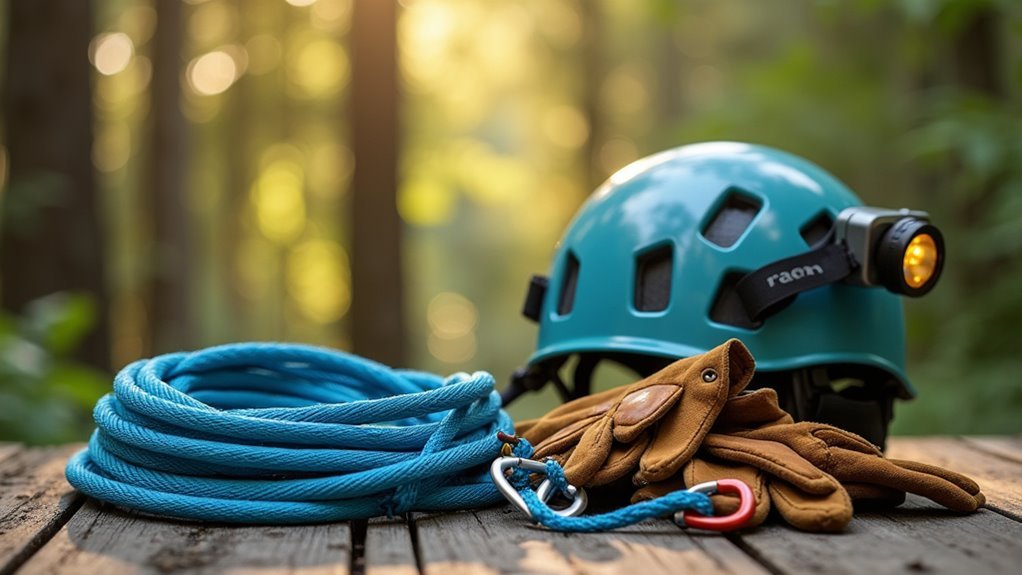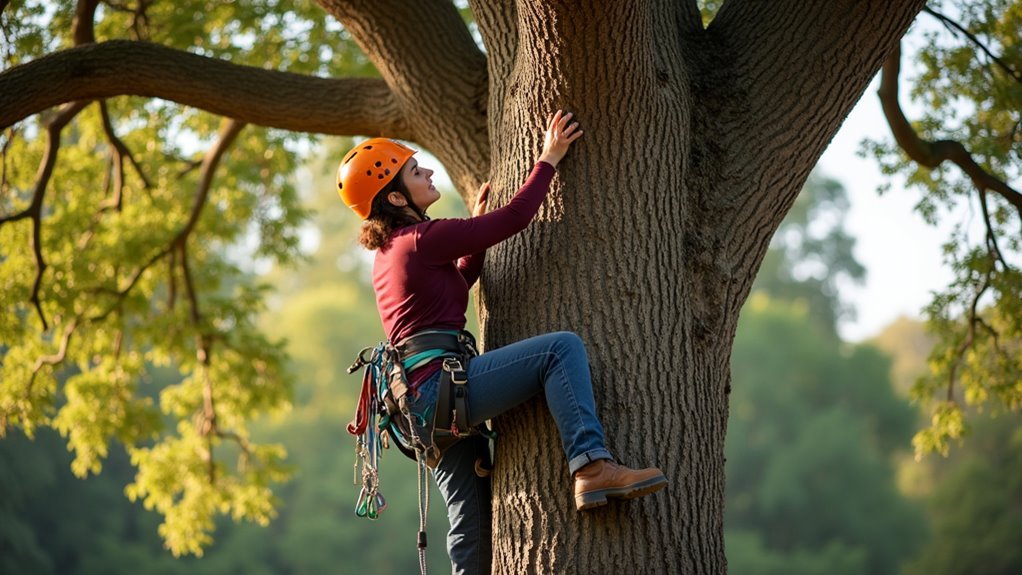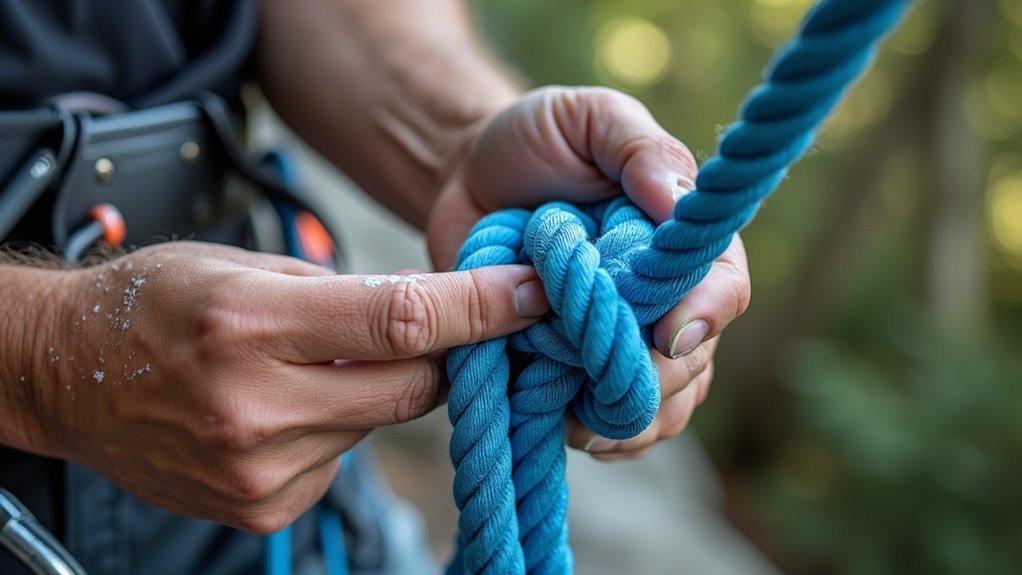Some of the links in this article may be affiliate links. If you make a purchase through these links, we may earn a small commission at no extra cost to you. Thank you.
I was just reflecting on my last geocaching adventure when I spotted a cache icon perched 30 feet up a massive oak tree. Ever tried to reach a high-altitude hide without proper climbing techniques? I’ve seen too many geocachers attempt dangerous free-climbing that puts both themselves and the environment at risk. With the right gear and knowledge, you can safely access those five-star difficulty caches while experiencing a unique perspective of the forest canopy that most cachers never see.
Essential Gear for Technical Tree Climbing

The right gear can literally be a lifesaver when you’re dangling 40 feet up a massive oak hunting for that elusive cache.
I’ve learned this the hard way – your GPS unit might lead you to the perfect coordinates, but without proper climbing equipment, you’re stuck on the ground staring upward.
For safe tree climbing, you’ll need ascenders, carabiners, and a good throw line that won’t damage bark. Protective gear is non-negotiable – helmets protect against falling debris, and gloves, well, they’ve saved my hands countless times.
Basic Climbing Techniques for Geocachers
Climbing techniques for geocachers aren’t one-size-fits-all – they’ll vary depending on the cache difficulty rating and the specific tree you’re tackling.
For instance, Alfie’s Ultimate Free Climb requires free climbing skills to reach that first branch without aids, while something like Ab die Post! demands proper use of ropes and harnesses on fixed routes.
I always start with secure handholds and footing – trust me, this saved me countless times on caches like Havran nebo vrana where one slip could mean a nasty fall.
Remember, non-destructive methods are non-negotiable; those Tree-o-Caching guidelines prohibit spikes for good reason.
For descent techniques, well… I learned the hard way that controlled rope descent is essential, especially for deep caches like Dragon’s Hole with its 61-meter drop.
Understanding Tree Safety and Selection

Before you even reach for that first branch, I’ll tell you that selecting the right tree is absolutely essential for both your safety and the environment’s protection.
In my experience, a proper pre-climb inspection involves checking for signs of disease, structural weakness, or wildlife habitation, which you’ll need to do regardless of whether you’re climbing an oak with its sturdy lateral branches or a pine with its more vertical climbing pattern.
Different tree species offer unique climbing experiences—pines might require more upper body strength while maples often provide better natural handholds—but whatever you choose, remember that geocaching communities strongly discourage climbing trees that show any signs of instability.
Assessing Tree Health
A successful geocaching expedition relies heavily on your ability to assess tree health before attempting any climb.
I always look for signs of pest detection first—those little bore holes or unusual leaf patterns can tell you if the tree’s structurally compromised.
Trust me, you don’t want to be halfway up when you realize the branches can’t support you!
Age estimation is something I’ve gotten better at with practice.
Older trees—especially those that seem ancient—often have hidden dead zones that aren’t obvious from ground level.
Check for nutrient deficiency too, which shows up as yellowing leaves or stunted growth.
In my experience, a tree suffering from poor nutrition is like, well, an athlete without proper fuel—it simply won’t perform when stressed with your weight and gear.
Species-Specific Climbing Considerations
When choosing the right tree species for geocaching climbs, which species should you trust with your safety? I’ve learned that hardwoods like oak and maple typically offer the best support for climbers. They’ve got thicker bark for better grip, too—something I appreciate when I’m 30 feet up!
| Species | Climbing Safety | Animal Interactions | Climate Adaptations |
|---|---|---|---|
| Oak | Excellent | Nesting birds | Drought resistant |
| Maple | Very good | Few pests | Cold tolerant |
| Pine | Poor (brittle) | Sap attracts insects | Wind vulnerable |
| Birch | Fair | Woodpecker habitat | Prefers cool areas |
From historical uses as navigation markers to modern geocaching, trees have always guided explorers. Just remember—young conifers aren’t your friends here! They’re easily damaged and don’t provide stable branches.
Pre-Climb Inspection Protocol
Knowing which tree species work best is one thing, but I’ve learned the hard way that proper inspection before any climb can literally save your life.
I always schedule my Inspection Timing for early morning when light conditions are ideal.
When I’m setting up a treocaching adventure, I don’t just eyeball things—I follow a systematic approach that guarantees I won’t be halfway up when I discover a problem.
- Check the tree’s overall health—look for fungus, dead branches, or disease signs
- Assess root system and trunk stability (remember, 30+ cm diameter at chest height!)
- Scout the surroundings for hazards like power lines or wildlife nests
- Use binoculars to evaluate high branches—this saves time and improves Team Coordination
Documentation Standards matter too. I always photograph potential issues before climbing, which helps with future reference.
Knots Every Climbing Geocacher Should Know

Effective knots stand between safety and disaster when you’re suspended twenty feet up a pine tree searching for that elusive geocache. I’ve found that mastering a few essential knots is non-negotiable for any serious climbing geocacher.
The bowline creates a secure loop that won’t slip when attached to your harness—it’s been saving lives since ancient sailing days.
For connecting to your harness, nothing beats the figure-eight follow-through with its under 5% failure rate.
The figure-eight follow-through is your lifeline—reliability measured in single-digit failure rates when your feet leave solid ground.
I think the clove hitch‘s evolution has made it perfect for quick tree anchoring, though it needs backup.
When you need to move up or down a fixed line, the Prusik is your friend, holding up to 300 pounds when properly wrapped.
And don’t forget the double fisherman’s knot—it’s not the prettiest, but it’ll join ropes with over 90% strength retention.
Ascending Systems for Reaching High Caches
I’ve found that mastering a few key ascending systems can make the difference between reaching that elusive T5 cache and going home empty-handed.
You’ll need to understand single rope techniques and the right hardware choices—whether you prefer mechanical ascenders, prusik hitches, or a combination of both for your climbs.
In my experience, the most practical methods balance safety with efficiency, allowing you to conserve energy during the ascent so you’ve still got something left when you finally need to search for that cleverly hidden container.
Single Rope Technique Basics
The adventure of reaching for hidden geocaches high up in the canopy begins with a technique that’s both elegant and effective—Single Rope Technique (SRT).
I’ve found that despite its modern adaptations, SRT’s origins actually trace back to cave exploration before it revolutionized tree climbing.
While some SRT myths suggest it’s only for professionals, I believe anyone can learn with proper training and equipment.
When I’m setting up for a treocaching ascent, I always follow this essential process:
- Throw or shoot your rope over a strong, high branch
- Secure your rope with appropriate anchoring
- Attach your ascending devices (I prefer mechanical ascenders over Prusik knots)
- Double-check everything before leaving the ground—trust me, you’ll thank yourself later!
Ascending Hardware Options
When it comes to reaching those tantalizingly high geocaches, what equipment should you choose? I’ve found that your gear selection really depends on both the terrain rating and your personal comfort level. For those T5 caches like Ab die Post!, you’ll need professional climbing gear—no shortcuts here! In my experience, the aesthetics of your gear matter less than functionality, though some suppliers (I’m looking at you, BlackDiamond) consistently deliver both.
| Ascending Option | Best For | Height Range | Gear Aesthetics |
|---|---|---|---|
| Fixed-rope systems | Steep gorges | 30-60m | Minimal, practical |
| Harness & rope | Tree caches | 10-30m | Customizable colors |
| Pole rods | Quick retrieves | 3-10m | Utilitarian, basic |
| Ladders | Urban caches | 2-8m | Simple but effective |
Practical Climbing Methods
How exactly do you safely reach that elusive geocache perched 30 feet above your head?
I’ve tackled many high-altitude hides, and the right ascending system makes all the difference.
Looking at caches like Ab die Post! or Dragon’s Hole, I’ve learned that different terrain demands specific approaches.
- Free Soloing – used in Alfie’s Ultimate cache but honestly, I’d never recommend this without serious experience (and a death wish!)
- Fixed-Rope Routes – perfect for steep gorges like in Ab die Post!, requiring full climbing gear
- Crack Climbing – excellent technique for natural rock features when trees aren’t available
- Non-Destructive Tree Systems – always prioritize methods that won’t damage our leafy friends
Environmental Ethics of Tree-Based Geocaching
Why should we care about environmental ethics when pursuing our geocaching adventures in trees?
Well, it’s simple—we’re guests in nature’s home.
Through Ethical Education, we learn that damaging equipment like spikes harms tree bark, potentially killing the very trees we enjoy climbing.
I’ve found that embracing Conservation Advocacy means distributing our impact by placing caches in groves rather than single trees.
This prevents the “loved to death” syndrome I’ve seen in popular climbing spots.
For Green Practices, I recommend switching from traditional container caches to simple plaques.
They’re less intrusive and—wait, that’s not quite right—they actually introduce fewer foreign materials into natural habitats.
Weather Considerations for Safe Tree Climbing
I’ve learned the hard way that wind is your biggest enemy when you’re twenty feet up a pine seeking that elusive cache – if branches start swaying more than slightly, it’s definitely time to descend.
Rain creates dangerously slippery bark and gear, so I always check weather forecasts at least 12 hours before my nighttime treocaching adventures.
While you might feel disappointed canceling a climb, trust me, there’s nothing more important than your safety when balancing between treetops in the darkness.
Wind Safety Protocols
When should you abandon your tree climbing plans for geocaching?
I’ve learned the hard way that wind hazards are non-negotiable safety concerns.
Psithurism—that rustling sound leaves make—isn’t just pretty; it’s a warning system.
I always check conditions before attempting high-altitude hides at 6+ meters, especially when gust mitigation becomes challenging.
Storm preparedness means recognizing when to walk away.
Trust me, no geocache is worth the risk when trees start swaying.
Your harness and ropes can only help so much.
- Wind speeds that cause noticeable tree movement
- When you hear significant leaf rustling (psithurism)
- Forecasted gusts exceeding what your training prepared you for
- If you feel unstable during your initial climb up to 3 meters
Rain Threat Assessment
How dramatically rain changes the tree climbing equation for geocachers!
I’ve seen even experienced climbers make critical errors when they underestimate the impact of precipitation on bark grip. Historical patterns show that most tree-climbing accidents occur when wet conditions weren’t properly assessed.
Regional differences matter too—what’s a light drizzle in the Pacific Northwest might be considered heavy rain elsewhere. I always recommend consulting multiple weather sources since forecasting errors can literally leave you hanging in a dangerous situation.
You know, I once thought I could beat a light shower to grab a cache, but—wait, that was stupid—I quickly abandoned the attempt when the bark became slick.
Think of wet tree climbing like driving on ice: technically possible, but why risk it? Remember, the cache will still be there when conditions improve.
Training Resources for Novice Climbing Geocachers
Where can novice geocachers learn the ropes of tree climbing without risking life and limb?
I’ve found several excellent resources that’ll help you safely reach those terrain-five caches.
Tree-o-Caching offers webinar series specifically targeting beginners in technical climbing—I think they’re particularly valuable for building skills step-by-step.
Tree-o-Caching’s beginner webinars build crucial technical climbing skills incrementally—perfect for novices tackling their first treetop caches.
For more personalized guidance, Tree Climbers International is just a call away at 404-377-3150.
- Rock Chalk’s three essential techniques for accessing high-altitude caches safely
- Tree-o-Caching’s certified training programs and professional equipment recommendations
- Online courses and community forums through the Geocaching app
- Training manuals with terrain-level five filters to prepare for challenging climbs
Descending Safely After Finding Your Cache
Once you’ve located your cache high in the treetops, you’ll need to get back down safely—I’d argue this is actually more dangerous than the climb up!
I’ve learned through rappel feedback that most descent hazards occur when we’re tired.
After the excitement of finding that T5 cache like Ab die Post!, fatigue recovery becomes essential.
Always use a static rope at least as long as your climb—like that 61-meter one needed for Dragon’s Hole.
Never rush down!
I once made that mistake and, well, let’s just say my heart was in my throat.
Check your anchors twice, wear your helmet, and descend with controlled movements.
Think of it like walking downstairs with your eyes closed—slow and deliberate is better than quick and sorry.
Documenting Your High-Altitude Geocache Adventures
Why let all that adrenaline and achievement go undocumented when you’ve just conquered a treetop geocache?
Sharing your Tree-o-Caching adventures isn’t just fun—it’s actually part of the game!
Remember to capture your entire journey using StoryCaptures that showcase your climb from gear-up to discovery.
When posting your AdventureLogs online, always include the #TreeOCache hashtag plus the cache number.
This acts as your virtual signature in the community.
If you’re looking to score that $20 TreeStuff gift certificate, your VideoHashtags need to accompany a complete adventure video.
- Include footage of your gear preparation
- Show the approach to the trailhead
- Document your safe climbing techniques
- Capture your reaction when finding the cache plaque
I’ve found that adding my adventures to the interactive map helps fellow climbers discover new challenges while building our unique community.
Frequently Asked Questions
At What Age Can Children Safely Begin Technical Tree Climbing?
Like young birds finding wings, I’d say around 8-10 years old with proper Age Guidelines. I guarantee Safety Training comes first, and I always recommend Parental Involvement throughout the learning process.
How Long Does a Typical High-Altitude Geocache Climb Take?
I’d say climb duration typically ranges from 30 minutes to 3 hours. Terrain influence greatly impacts time—dense branches slow progress, while gear efficiency determines your setup and climbing speed.
Can I Tree Climb Alone or Is a Partner Required?
I never recommend solo climbing. Alone, you face increased risks without backup; with partners, you gain safety and better group dynamics. Always climb with someone who can assist in emergencies.
Are There Weight Limits for Tree Climbing Equipment?
Yes, each piece of equipment has specific user weight limits. I always check manufacturer specifications, as carabiners, harnesses, and ropes undergo testing standards to establish their equipment limits. Never exceed these ratings.
How Do You Handle Unexpected Wildlife Encounters While Climbing?
I always prioritize Wildlife Training before climbing. I’ll freeze, speak calmly, and back away slowly when encountering animals. Habitat Awareness helps me anticipate residents and adapt my Encounter Strategies accordingly.